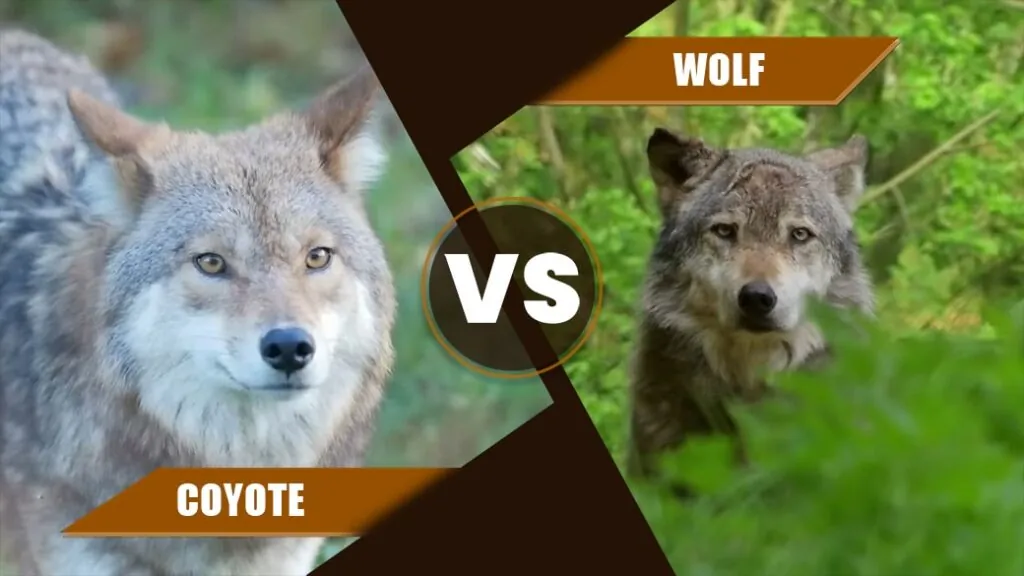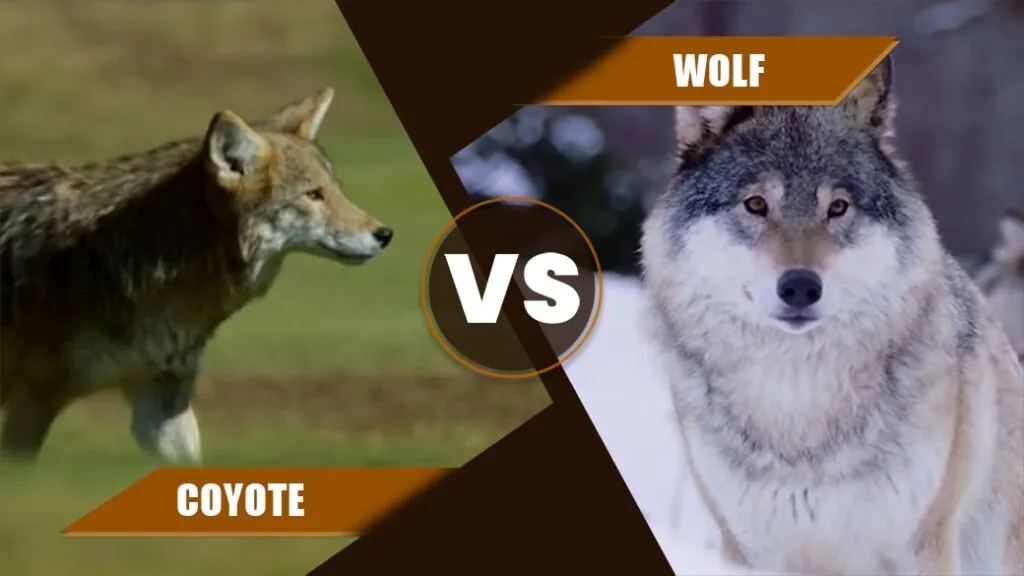Wolf vs Coyote Unchained: Face-off Fury in an Engaging Battle!

Ever mulled over what happens when the haunting howl of wolf encounters the crafty symphony of the coyote in the untamed wild? Well, get ready to be stunned as we’re going to unravel the thrilling saga of wolf vs coyote. The stage is configured, the battleground vast and you’re about to set on a journey where size, speed and survival interweave in the primal dance of nature. Without further ado, let’s spotlight the difference between wolf and coyote.
| Attribute | Wolf | Coyote |
|---|---|---|
| Scientific Name | Canis lupus | Canis latrans |
| Number of Species | 3 | 19 recognized subspecies |
| Height | 2 to 2.5 feet at the shoulder | Around 1 to 1.5 feet at the shoulder |
| Length | 4.5 to 6.5 feet (including tail) | 3.5 to 4.5 feet (including tail) |
| Weight | 40 to 175 pounds (varies by species) | 20 to 50 pounds (varies by region) |
| Top Speed | 31 to 37 mph | 32 to 43 mph |
| Habitat | Diverse, including forests, tundra, and grasslands | Varied habitats such as deserts, grasslands, and urban areas |
| Prey / Diet | Carnivorous, primarily hunting large ungulates | Omnivorous, feeding on small mammals, birds, insects, and plants |
| Bite Force | Pack-oriented, with a complex social hierarchy | Generally more solitary or found in smaller family groups |
| Lifespan | 6 to 8 years in the wild (varies by species) | 10 to 14 years in the wild |
| Distinctive Feature | Larger size, robust build, bushy tail, and prominent snout | Smaller size, slender build, and a more pointed snout |
| Conservation Status | Least Concern | Least Concern |
Cultural and Historical Significance
Ancient Myths or Folklore
Traversing the corridors of ancient myths and folklore, wolves and coyotes imprint their essence in the narratives of distinct cultures. Coyote, in Native American traditions, assumes the role of a wily trickster, weaving mischief into the fabric of stories; wolves, on the flip side, appear as emblems of courage and loyalty.
Significance in Various Cultures
The symbolic weight of wolves differ across cultures, personifying guardianship, familial bonds and fearlessness. Meanwhile, coyotes are featured as clever and adaptable beings, exemplifying survival instincts in the lore of distinct traditions.
Physical Characteristics
Size
In the realm of overall appearance, wolves stand as majestic giants. They carry an air of strength and authority with the weight ranging from 50 to 130 pounds, the average height of 26 to 32 inches and the length spanning 4.5 to 6.5 feet.
Contrastingly, coyotes, with the height of 20 to 22 inches, the length of 3.5 to 4.5 feet and the weight ranging from 20 to 50 pounds, showcase a more modest scale.
Coat
What makes the notion of wolf vs coyote more crystal clear is their color and pattern. Wolves, displaying a breathtaking array of coat colors, ranging from shades of gray, black, brown to white, paint the canvas of their existence. Coyotes, on the flip side, frequently bear a grayish-brown coat, embellished with a reddish tint on their legs and ears.
Distinctive Features
Wolves, one of the cool animals in the world, feature a distinctive lion-like mane around their necks – a regal characteristic setting them apart. Coyotes, discerned by their pointed ears and facial features, evoke a resemblance of the tear marks festooned by cheetahs.
Habitat and Distribution
Forests, expansive wilderness, tundras and mountainous landscapes are the environments wolves prefer the most. Coyotes, featuring a unique adaptability, flourish in an assortment of environments, including deserts, forests and urban landscapes.
Range and Territories
As territorial custodians, wolves lay claim to vast stretches, their territories spanning hundreds of square miles. Meanwhile, coyotes navigate more compact ranges in their resourceful manner, exhibiting an adaptability vital for survival in fragmented habitats.
Population
Wolves reside in a varied range of geographical locations, including North America, Europe, Asia and parts of the Middle East. Specific species, such as red wolf and Ethiopian wolf, enjoy distinct ranges. Being highly adaptable, coyotes are located throughout North and Central America, stretching into urban environments as human developments swells.
Behavior and Lifestyle

Social Behavior
Social behavior of both species is another factor to benchmark the notion of wolf vs coyotes. Wolves come forth as highly social beings, navigating the intricacies of a pack structure that manifests familial bonds. Coyotes, while social as well, tend to structure family groups, mirroring a more nuanced social architecture.
Hunting Techniques
Wolves, to subdue large prey like elk and bison, showcase prowess as collaborative hunters, orchestrating strategic maneuvers. Coyotes, versatile in their technique, seamlessly substitute between solo hunting and cooperative tactics, adapting to the accessibility of resources. For interesting audio samples of both wolf and coyote vocalizations, you can visit the website of the Yellowstone National Park Service.
Diurnal vs. Nocturnal Activities
In the wild, the rhythm of their doings diverges, that is, wolves, chiefly crepuscular, are most active in the course of dawn and dusk, while coyotes most often than not under the veil of night, feature a penchant for nocturnal endeavors, specifically in areas interwoven with human presence.
Conservation Status
Current IUCN Status
According to the International Union for Conservation of Nature (IUCN) classification, both wolves and coyotes, as custodians of biodiversity, contemporarily occupy the status of “Least Concern.”
Threats
The existence of both majestic creatures is not untouched by the challenges of the modern world. Wolves encounter threats, such as hunting, habitat loss and conflicts with humans. Coyotes, too, grapple with the repercussions of habitat fragmentation and, in particular regions, intensive predator control programs.
In Popular Culture
Movies
On the silver screen, wolves have left an awe-inspiring mark, with prominent appearance in movies, such as “Dances with Wolves,” whereby their untamed beauty provides a backdrop to Kevin Costner’s journey.
Contrary to that, coyotes most often than not make animated forays, with characters like Wiley Coyote in Looney Tunes, manifesting both relentless pursuit and resilience.
Documentaries
Documentaries like “The Wolves of Yellowstone” dig deep into the intricacies of pack dynamics and their pivotal role in ecosystems. Coyotes unravel the secrets behind their outstanding adaptability, taking the spotlight in documentaries, such as “Meet the Coywolf.”
Literary Works
The enigmatic nature and pack dynamics of wolves are unfolded in literary works, such as “White Fang” by Jack London and “The Call of the Wild.” On the part of coyotes, albeit less prevalent in literature, maintain their spot in narratives that feature the wild spirit, with authors like Terry Tempest Williams shedding light on their significance in the American West in works such as “Refuge.”
These comparative percentages, pinpointing the realm of “wolf vs coyote,” are ballpark figures for a quick rundown and aren’t scientifically precise. Actual differences can fluctuate thanks to variables like species, environment and individual variations.





